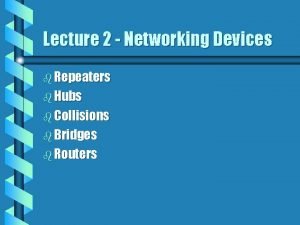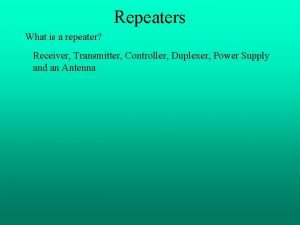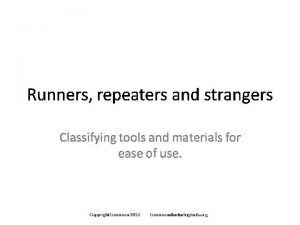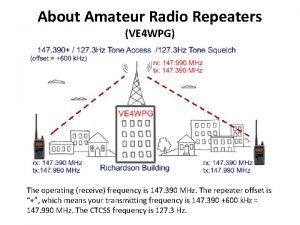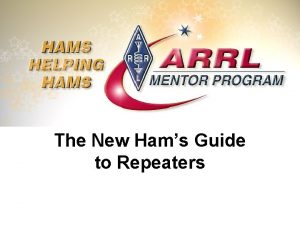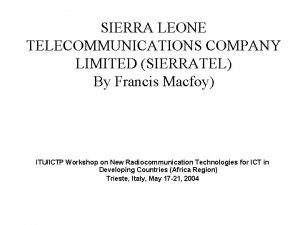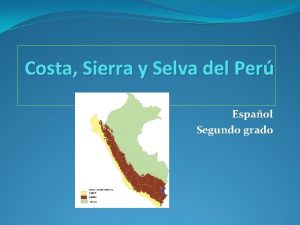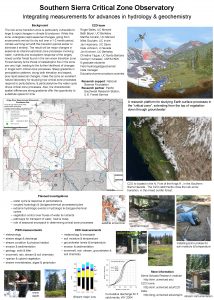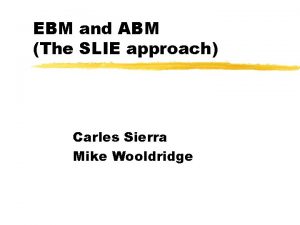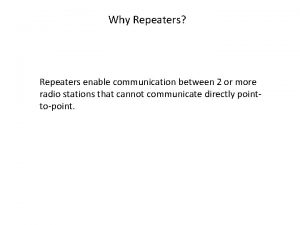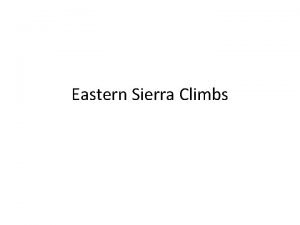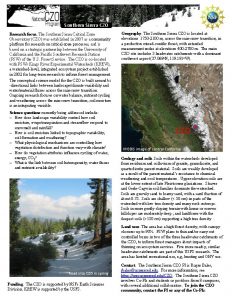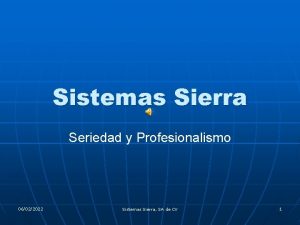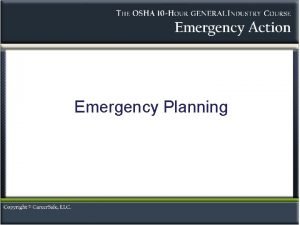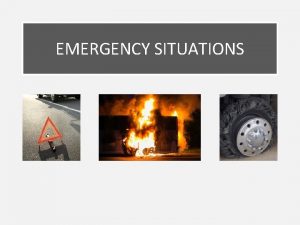REPEATERS SIERRA INTERMOUNTAIN EMERGENCY ASSOCIATION WHY REPEATERS 1






































- Slides: 38

REPEATERS SIERRA INTERMOUNTAIN EMERGENCY ASSOCIATION

WHY REPEATERS? 1. Extend the range of our low power portables and mobiles. 2. Provides the means for communications throughout a geographic community.

THE SIERA REPEATER • Located on Leviathan peak, about 30 miles south of Gardnerville at about 8900 ft. • Receives on 147. 930 MHz • Requires a PL of 123 Hz • Transmits on 147. 330 MHz, ERP 25 watts

LEVIATHAN VIEWED FROM MONITOR PASS HIGHWAY

GEORGE UEBELE AND WILL LEWIS JULY 29, 2005

Leviathan Repeater building

Leviathan equipment room

SIERA repeater

LEVIATHAN SOLAR PANELS

LEVIATHAN LOOKING EAST

LEVIATHAN LOOKING NORTHEAST

LEVIATHAN LOOKING NORTH

LEVIATHAN LOOKING WEST

LEVIATHAN LOOKING SOUTH

TARA REPEATER • • Located on East Peak at about 9500 feet Receives on 147. 840 MHz Sometimes requires a PL of 123 Hz Transmits on 147. 240 MHz

East Peak Antenna Tower

East Peak View of Lake Tahoe

East Peak View of Lake Tahoe to North

East Peak View of South Lake Tahoe

East Peak View to Southeast towards Carson Valley

East Peak View to East towards Carson Valley

East Peak View to Northeast towards Carson City

W 7 DI REPEATERS • Located on Mc. Clellan Peak, north of Carson City at about 7400 ft • Two repeaters linked together • Receives on 147. 870 MHz • Requires PL of 123 Hz • Transmits on 147. 270 MHz, ERP 100 watts • Receives on 446. 250 MHz • Requires PL of 123 Hz • Transmits on 441. 250 MHz, ERP 80 watts

Mc. Clellan Peak Antenna Farm

Mc. Clellan Peak. April North 13, Side 2011 of Equipment Building

Mc. Clellan Peak W 7 DI Repeaters VHF in front on bottom UHF in back on top

MINDEN REPEATER Receives 448. 750 MHz - No PL Transmits 443. 750 MHz - ERP 20 watts Linked to Mc. Clellan repeaters

REPEATER REQUIREMENTS • • Must be able to transmit and receive simultaneously Requires two antennas or a duplexer Requires a controller Must meet Site Managers specifications

DUPLEXERS • Duplexers allow you to transmit and receive simultaneously on a common antenna • Duplexers are made up of 4 or more cavities • A cavity passes a narrow bandwidth centered on its resonant frequency

DUPLEXERS 147. 930 Receiver r 147. 930 147. 330 Transmitter 147. 330

COAXIAL CABLE • Loss in coax cable increases with frequency • Larger cable has less loss than smaller COAX TYPE RG 58 RG 8 1/2" Heliax 7/8" Heliax ATT/100 FEET POWER OUT WITH 100 AT 2 METERS WATTS IN 6 db 1. 5 db. 8 db. 45 db 25 watts 71 watts 83 watts 90 watts ATT/100 FEET AT POWER OUT WITH 100 70 CENTIMETERS WATTS IN 9 db 3 db 1. 4 db. 8 db 13 watts 50 watts 72 watts 83 watts TARA repeater has 410 ft of 7/8” Heliax with a loss of 1. 85 db COST/FT 0. 30 1. 00 3. 00 7. 00

CONTROLLERS • Must be able to turn the repeater off and on • Must ID at required intervals • Needs a timeout timer • Other options: o o Courtesy tones Hang time Announcements Auxillary controls

CONTROL OPERATOR • A control operator is required any time an amateur transmitter is in operation • For repeater operation, the FCC allows remote control. The repeater control operator(s) can monitor and control its operation by some form of control link from one or more distant locations. • A radio control link uses an auxiliary frequency to control the repeater. Auxiliary frequencies must be above 222. 15 MHz • Control codes should be known only by the licensee and control operators

AUTOMATIC CONTROL • (Automatic control) the use of devices and procedures for control of a station when it is transmitting so that compliance with the FCC Rules is achieved without the control operator being present at a control point. § 97. 3 (a)(6) • In the event of improper use of the machine, the licensee is responsible for correcting the problem as soon as practicable and for making sure that the problem will not happen again (ARRL rule book) • Although no control operator is required to be present at a control point while the repeater is operating under automatic control, it is still the station licensee’s responsibility to see that the repeater operates properly at all times (ARRL rule book)

FREQUENCY MODULATION • Frequency modulation is the process of using an audio signal to cause the RF carrier frequency to swing up and down • The audio level determines how far the RF carrier swings • The ideal audio level for ham radios will cause the frequency to deviate by ± 5 KHz

COMMON PROBLEMS • Improper modulation o Low audio levels will result if deviation is less than ± 5 KHz o Audio levels exceeding ± 5 KHz can result in distortion o Radios and microphones vary in sensitivity

COMMON PROBLEMS • Not enough power o The RF signal into the repeater is not enough to “quiet” the receiver. o There will be background noise or you may not “hold” the repeater o Yelling into the microphone will usually not improve your signal if you have low power into the repeater o Most repeaters “talk out” further than they can “hear”

PUBLIC SERVICE • § 97. 1 Basis and purpose (of amateur radio) • (a) Recognition and enhancement of the value of the amateur service to the public as a voluntary noncommercial communication service, particularly with respect to providing emergency communications. • Our ability to have repeaters located in public facilities is because of agreements with public officials to provide these services.
 Andreas carlsson bye bye bye
Andreas carlsson bye bye bye Intermountain plateau
Intermountain plateau California intermountain region
California intermountain region Intermountain tesol
Intermountain tesol Repeaters and hubs
Repeaters and hubs Nhrc repeater controller
Nhrc repeater controller Runners repeaters strangers
Runners repeaters strangers Manitoba repeater society
Manitoba repeater society Travelplus for repeaters
Travelplus for repeaters Law enforcement and emergency services video association
Law enforcement and emergency services video association Don't ask why why why
Don't ask why why why Sierra proto express
Sierra proto express Sierra leone telecommunications company
Sierra leone telecommunications company Sierra leone medium term development plan
Sierra leone medium term development plan Curriculum verde
Curriculum verde Diversidad étnica del perú
Diversidad étnica del perú Sierra madre planning department
Sierra madre planning department Mario alberto casas sierra
Mario alberto casas sierra El capishca es un ritmo de la
El capishca es un ritmo de la Qué son los géneros literarios
Qué son los géneros literarios Plantas sin semilla para niños
Plantas sin semilla para niños Physical features of latin america map
Physical features of latin america map Sierra madre mountains map
Sierra madre mountains map Sierra
Sierra La flora de la costa
La flora de la costa Dina rafaela sierra rochels
Dina rafaela sierra rochels Carretera longitudinal de la sierra
Carretera longitudinal de la sierra Golden sierra workforce development board
Golden sierra workforce development board Sierra nevada grizzly spider
Sierra nevada grizzly spider Sierra nevada uplift
Sierra nevada uplift Cornry
Cornry Eastern sierra observatory
Eastern sierra observatory Jemez principles sierra club
Jemez principles sierra club Camila garcia sierra
Camila garcia sierra Osmosis definition biology
Osmosis definition biology Como interpretar un climograma
Como interpretar un climograma Language tool
Language tool Economia de morona santiago
Economia de morona santiago Reminiscence of sierra
Reminiscence of sierra




